
The plain-mantled tit-spinetail is a small passerine bird of South America in the Furnariinae subfamily of the ovenbird family Furnariidae. It is found in Argentina, Bolivia, Chile, and Peru.

The austral canastero is a species of bird in the Furnariinae subfamily of the ovenbird family Furnariidae. It is found in Argentina and Chile.

Hudson's canastero is a Near Threatened species of bird in the Furnariinae subfamily of the ovenbird family Furnariidae. It is found in grasslands in Argentina, Brazil, and Uruguay.

The scribble-tailed canastero is a species of bird in the Furnariinae subfamily of the ovenbird family Furnariidae. It is found in Argentina, Bolivia, and Peru.

The Junin canastero is a species of bird in the Furnariinae subfamily of the ovenbird family Furnariidae. It is endemic to Peru.

The Peruvian seaside cinclodes or surf cinclodes is a species of bird in the Furnariinae subfamily of the ovenbird family Furnariidae. It is endemic to Peru.

The light-crowned spinetail is a species of bird in the Furnariinae subfamily of the ovenbird family Furnariidae. It is found in Bolivia and Peru.

The speckled spinetail is a species of bird in the Furnariinae subfamily of the ovenbird family Furnariidae. It is found in Bolivia, Brazil, Colombia, Ecuador, French Guiana, Peru, Suriname, and Venezuela.
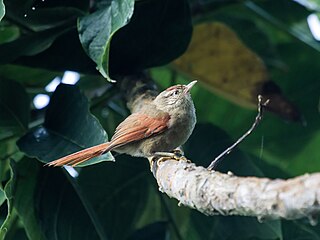
The streak-capped spinetail is a species of bird in the Furnariinae subfamily of the ovenbird family Furnariidae. It is found in Colombia and Venezuela.

The Bolivian spinetail is a Vulnerable species of bird in the Furnariinae subfamily of the ovenbird family Furnariidae. It is endemic to Bolivia.
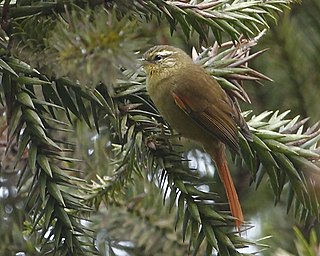
The olive spinetail is a species of bird in the Furnariinae subfamily of the ovenbird family Furnariidae. It is found in Argentina, Brazil, and Paraguay.

The stripe-crowned spinetail is a species of bird in the Furnariinae subfamily of the ovenbird family Furnariidae. It is found in Argentina, Bolivia, Brazil, Paraguay, and Uruguay.
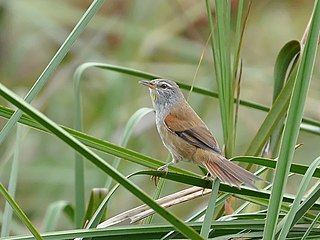
The sulphur-bearded reedhaunter or sulphur-throated spinetail is a species of bird in the Furnariinae subfamily of the ovenbird family Furnariidae. It is found in Argentina, Brazil, and Uruguay.
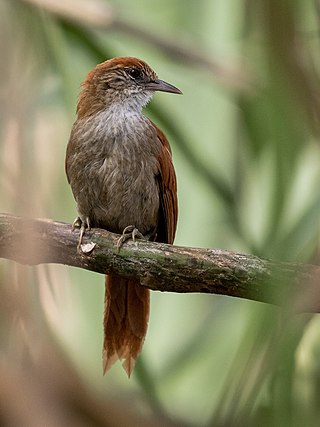
Parker's spinetail is a species of bird in the Furnariinae subfamily of the ovenbird family Furnariidae. It is found in Bolivia, Brazil, Ecuador, and Peru.

The white-striped woodcreeper is a species of bird in the subfamily Dendrocolaptinae of the ovenbird family Furnariidae. It is endemic to Mexico.

The brown-capped tit-spinetail is a species of bird in the Furnariinae subfamily of the ovenbird family Furnariidae. It is found in Argentina and Bolivia.
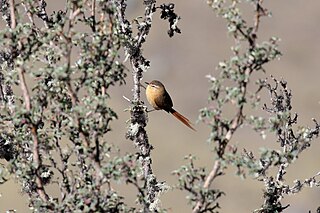
The tawny tit-spinetail is a species of bird in the Furnariinae subfamily of the ovenbird family Furnariidae. It is found in Argentina, Bolivia, and Peru.

The Itatiaia spinetail, also known as the Itatiaia thistletail, is a species of bird in the Furnariinae subfamily of the ovenbird family Furnariidae. It is endemic to southeastern Brazil.
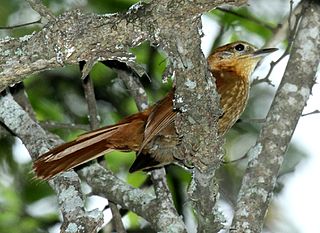
The rufous-necked foliage-gleaner is a Vulnerable species of bird in the Furnariinae subfamily of the ovenbird family Furnariidae. It is found in Ecuador and Peru.

The uniform treehunter is a species of bird in the Furnariinae subfamily of the ovenbird family Furnariidae. It is found in Colombia and Ecuador.























